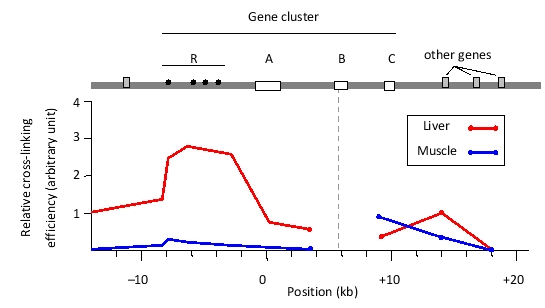Short Answer
You have performed a chromosome conformation capture (3C) experiment to study chromatin looping at a mouse gene cluster that contains genes A, B, and C, as well as a regulatory region R. In this experiment, you performed in situ chemical cross-linking of chromatin, followed by cleavage of DNA in the nuclear extract with a restriction enzyme, intramolecular ligation, and cross-link removal. Finally, a polymerase chain reaction (PCR) was carried out using a forward primer that hybridizes to a region in the active B gene, and one of several reverse primers, each of which hybridizes to a different location in the locus. The amounts of the PCR products were quantified and normalized to represent the relative cross-linking efficiency in each analyzed sample. You have plotted the results in the graph below. The same experiment has been done on two tissue samples: fetal liver (represented by red lines) and fetal muscle (blue lines).
Interaction of the A, B, and C genes with the regulatory R region is known to enhance expression of these genes. Indicate true (T) and false (F) statements below based on the results. Your answer would be a four-letter string composed of letters T and F only, e.g. TTTF.

( ) The B gene would be predicted to have higher expression in the fetal liver compared to the fetal muscle tissue.
( ) Interaction between the R region and the B gene involves the A gene looping out.
( ) Interaction between the R region and the B gene involves the C gene looping out.
( ) In fetal muscle, the B gene definitely does not engage in looping interactions with any other elements in the cluster.
Correct Answer:

Verified
The 3C data show high relative cross-l...View Answer
Unlock this answer now
Get Access to more Verified Answers free of charge
Correct Answer:
Verified
The 3C data show high relative cross-l...
View Answer
Unlock this answer now
Get Access to more Verified Answers free of charge
Q1: To study the chromatin remodeling complex SWR1,
Q2: Findings from a number of experiments on
Q3: Indicate whether each of the following descriptions
Q4: Nucleosomes that are positioned like beads on
Q5: Assume two isolated human communities with 500
Q7: Chromosome 3 contains nearly 200 million nucleotide
Q8: Indicate which numbered feature (1 to 5)
Q9: Indicate which feature (1 to 4) in
Q10: Indicate whether each of the following histone
Q11: The two chromosomes in each of the